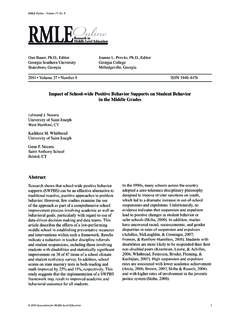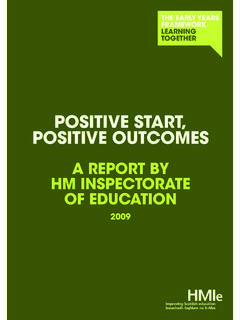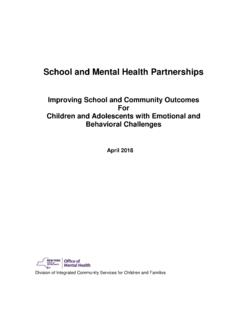Transcription of Improving access to greenspace: 2020 review - GOV.UK
1 Improving access to greenspace A new review for 2020 Improving access to greenspace : A new review for 2020 2 About Public Health England Public Health England exists to protect and improve the nation s health and wellbeing and reduce health inequalities. We do this through world-leading science, research, knowledge and intelligence, advocacy, partnerships and the delivery of specialist public health services. We are an executive agency of the Department of Health, and a distinct delivery organisation with operational autonomy to advise and support government, local authorities and the NHS in a professionally independent manner.
2 Public Health England Wellington House 133-155 Waterloo Road London SE1 8UG Tel: 020 7654 8000 Twitter: @PHE_uk Facebook: Crown copyright 2020 You may re-use this information (excluding logos) free of charge in any format or medium, under the terms of the Open Government Licence To view this licence, visit OGL. Where we have identified any third-party copyright information you will need to obtain permission from the copyright holders concerned. Published March 2020 PHE publications PHE supports the UN gateway number: GW-1158 Sustainable Development Goals Improving access to greenspace .
3 A new review for 2020 3 Contributors Harmony Ridgley Public Health England Angela Hands Public Health England Rebecca Lovell European Centre for Environment and Human Health, University of Exeter Carl Petrokofsky Public Health England Aimee Stimpson Public Health England Alison Feeley Public Health England Andrew Bedford Camden and Islington Councils Ben Fenech Public Health England David Leeman Public Health England Eleanor Sykes Public Health England Gabriele Price Public Health England Hamira Sultan Birmingham City Council Helen Macintyre Public Health England John Thorne Camden and Islington Councils Julie Hammon Dorset AONB Karen Exley Public Health England Martin Seymour Norfolk County Council Michael Brannan Public Health England
4 Collaborators Alice Stonham Public Health England Allan Baker Public Health England Anita Counsell Public Health England Benjamin Brown Landscape Institute Clare Olver The Mersey Forest Clare Warburton Natural England Dave Solly Natural England Dave Stone Natural England Delia Beck Sport England Graham Duxbury Groundwork Improving access to greenspace : A new review for 2020 4 Gunveer Plahe Public Health England James Stuart-Evans Public Health England Jane Houghton Natural England Judith Eling Surrey County Council Julia Thrift Town and Country Planning Association Karen Saunders Public Health England Michael Chang Public Health England Nick Clarke Public Health England Nick Grayson Birmingham City Council Peter Massini Greater London Authority Rachel Partridge Dorset County Council Rachel Toms Public Health England Raquel Duarte-Davidson Public Health England Robert Pearce The Parks Alliance Robie Kamanyire Public Health
5 England Sarah Preston Natural England Sari Kovats London School of Hygiene and Tropical Medicine Trudi Else Sport England Improving access to greenspace : A new review for 2020 5 Contents Glossary 6 Foreword 10 Executive summary 11 1. Introduction 15 2. Understanding the benefits of greenspace 20 3. Inequalities and greenspace 30 4. Understanding the value of greenspace 33 5. Engagement with greenspace 36 6. A practical call to action 44 7. Conclusion and recommendations 55 Appendix A: Evolution of evidence on health and greenspace 60 Appendix B: Health benefits associated with access to and use of green spaces 63 Appendix C: Literature review on inequalities and access to greenspace in the UK 68 Appendix D: Case studies 78 References 89 Improving access to greenspace : A new review for 2020 6 Glossary Term Definitions 25 YEP 25 Year Environment Plan.
6 AONB Area of Outstanding Natural Beauty. BAME/ BME Black and Minority Ethnic. Bluespace/ Blue infrastructure Outdoor environments, either natural or built, that prominently feature water such as streams, ponds, canals and other water bodies. CIL The Community Infrastructure Levy is a levy that local authorities can choose to charge on new developments in their area. The money should be used to support development by funding infrastructure that the council, local community and neighbourhoods want. Ecosystem services The components of nature that are directly and indirectly enjoyed, consumed, or used in order to maintain or enhance human well-being.
7 Environmental net gain Environmental Net Gain means Improving all aspects of environmental quality through a scheme or project. GLUD The Generalised Land Use Database classification has been developed which allocates all identifiable land features on Ordnance Survey MasterMap into simplified land categories. Green infrastructure A network of multi-functional green space, urban and rural, which can deliver a wide range of environmental and quality of life benefits for local communities. References to green infrastructure in this guidance also apply to different types of blue infrastructure where appropriate.
8 greenspace Any area of vegetated land, urban or rural. This includes both public and private spaces such as parks, gardens, playing fields, children s play areas, woods and other natural areas, grassed areas, cemeteries and allotments, green corridors, disused railway lines, rivers and canals, derelict, vacant and contaminated land which has the potential to be transformed. Green stormwater Infrastructure (GSI) An approach to moving stormwater away from the built environment aiming to reduce surface water flooding, improve water quality and enhance the amenity and biodiversity value of the environment. GSI attempts to mimic nature and uses simple landscaping features such as green roofs, rain gardens and bioswales to slow, collect, infiltrate, and filter stormwater.
9 Similar to Sustainable Urban Drainage Systems (SuDS). Improving access to greenspace : A new review for 2020 7 H2020 Horizon 2020 is the main European funding programme for research and innovation and aims to ensure that Europe produces world-class science, removes barriers to innovation and makes it easier for the public and private sectors to work together in delivering innovation. HiAP Health in All Policies is an approach to policies that systematically and explicitly takes into account the health implications of the decisions we make; targets the key social determinants of health; looks for synergies between health and other core objectives and the work we do with partners; and tries to avoid causing harm with the aim of Improving the health of the population and reducing inequity.
10 HWB A Health and Wellbeing Board is a forum where key leaders from the health and care system work together to improve the health and wellbeing of their local population and reduce health inequalities. Each Local Authority in England has a fully operational Health and Wellbeing Board. HWBS The Health and Wellbeing Strategy outlines the priority areas and how to work together to improve people's health and reduce health inequalities that exist in the population. ICS Integrated Care Systems are a way of working, collaboratively, between a range of health and social care organisations, to help improve people's health.














